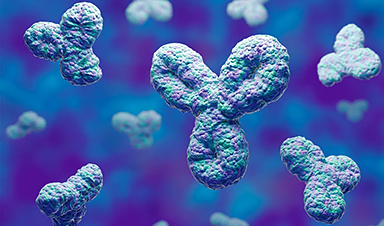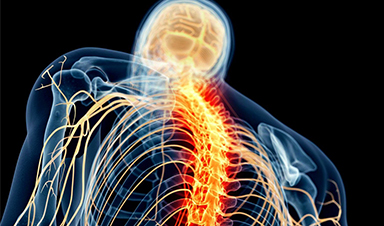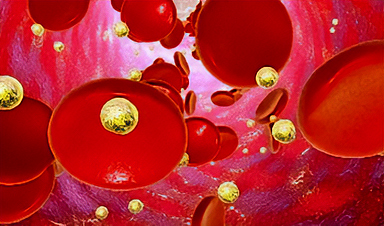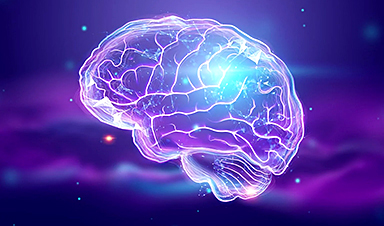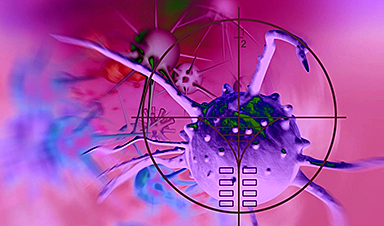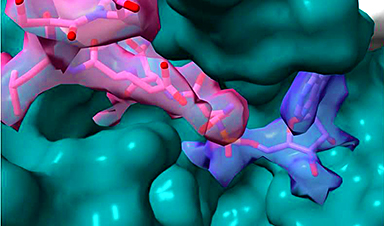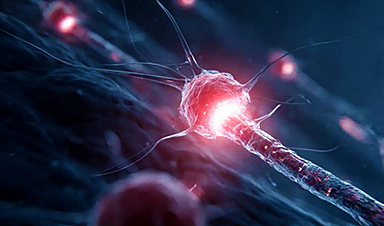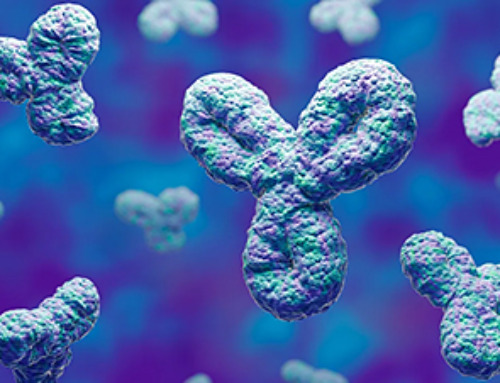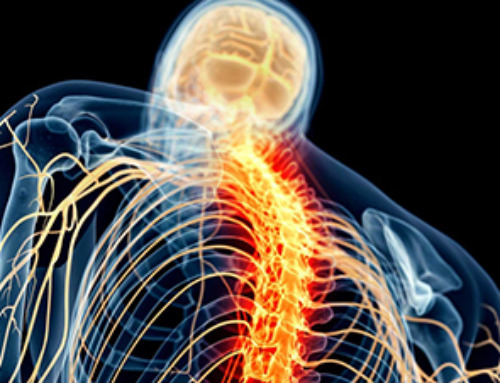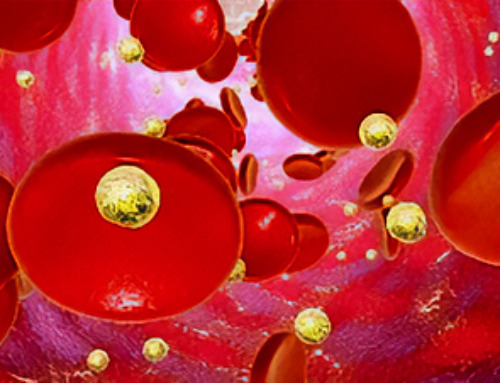A paper recently published in the journal ACS Omega reviewed the current status and potential of X-ray spectroptychography for the characterization of advanced nanomaterials.
What is X-ray Spectroptychography?
X-ray spectroptychography is an emerging technique that represents the ptychographic version of X-ray spectromicroscopy and is used for the chemical microanalysis of nanomaterials such as batteries and catalysts. This technique is based on the existing synchrotron X-ray spectromicroscopy and microscopy techniques with an added ptychography, an algorithmic imaging technique, for image acquisition.
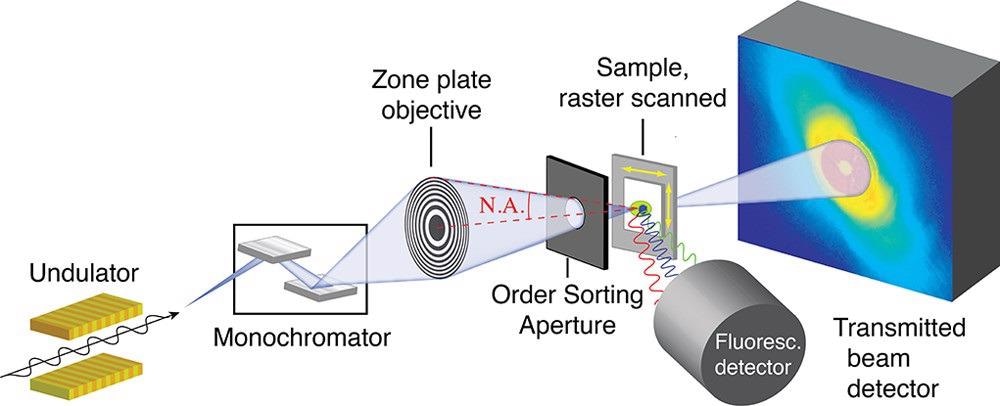
Figure 1. Schematic of a scanning transmission X-ray microscope. Adapted with permission from ref (45). Sample is raster scanned through the focused X-ray beam. In conventional STXM, transmission is measured by a serial detector downstream of the sample. In ptychographic STXM, a diffraction pattern is measured with a pixelated detector downstream of the sample, as shown in the figure. © Urquhart (2022)
X-ray spectroptychography provides a higher spatial resolution during chemical microanalysis compared to conventional X-ray optics. In traditional X-ray microscopes, the spatial resolution is limited by the focusing properties of their X-ray optics. However, ptychography can significantly enhance the spatial resolution of X-ray microscopy as this lensless imaging technique relies on the diffraction of coherent radiation by an amorphous sample.
Within coherent diffractive imaging (CDI), the forerunner of ptychography, the reconstruction of the image of an isolated object is based on the diffraction pattern of the object, which is obtained by the uniform illumination of the object. This factor limits the practical application of the technique. However, unlike the CDI method, ptychography utilizes a sequence of coherent far-field diffraction patterns obtained from the overlapping regions of the isolated sample without requiring the sample.
Ptychography microscopes use zone plates, refractive Laue lenses, Kirkpatrick−Baez mirrors, or pinholes to illuminate the test sample with a well-defined coherent probe. These optics provide a constant focal length when the X-ray energy is altered for spectroscopy.
Both phase and absorption can be utilized for ptychography image contrast. Phase contrast is more crucial in a hard X-ray measurement obtained from a test sample. X-ray spectroptychography can provide the full refractive index of a sample comprising the phase and absorption spectra.
X-Ray Spectroptychography Applications
In the last few years, the spatial resolution provided by X-ray spectroptychography was enhanced owing to the improvements in algorithms and instrumentation associated with the technique. Currently, the technique is used to study nanostructured energy materials such as magnetic materials and fuel cell cathodes.
Magnetic Materials
X-ray magnetic circular dichroism (XMCD) spectroptychography can be used to evaluate the magnetic nanostructure of materials. For instance, XMCD spectroptychography was used to investigate the out-of-plane magnetization in gadolinium/iron multilayer samples and study the nanoscale magnetite single crystals synthesized by magnetotactic bacteria.
Battery Materials
X-ray spectroptychography can provide a chemical characterization of battery materials at a higher spatial resolution compared to conventional X-ray spectromicroscopy and microscopy. Specifically, this technique provides an oxidation state mapping of particular metal ions with a high spatial resolution during battery cycles. For instance, iron L3-edge X-ray spectroptychography was used to map delithiation and lithiation through the corresponding changes in the iron 2p oxidation state.
The metal oxidation state was also mapped at hard X-ray energies using this technique. Spectroptychography is used for chemical mapping to monitor the relationship between the chemical and mechanical stability of lithium-ion batteries. The technique is also used for the elucidation of surface chemistry and minority phases.
Catalyst Materials
X-ray spectroptychography is used extensively to investigate catalyst materials as the improvement of these materials depends on high spatial resolution chemical mapping of heterogeneous materials. Additionally, this technique is also used to evaluate porosity in heterogeneous catalyst materials such as fluid catalytic cracking catalysts.
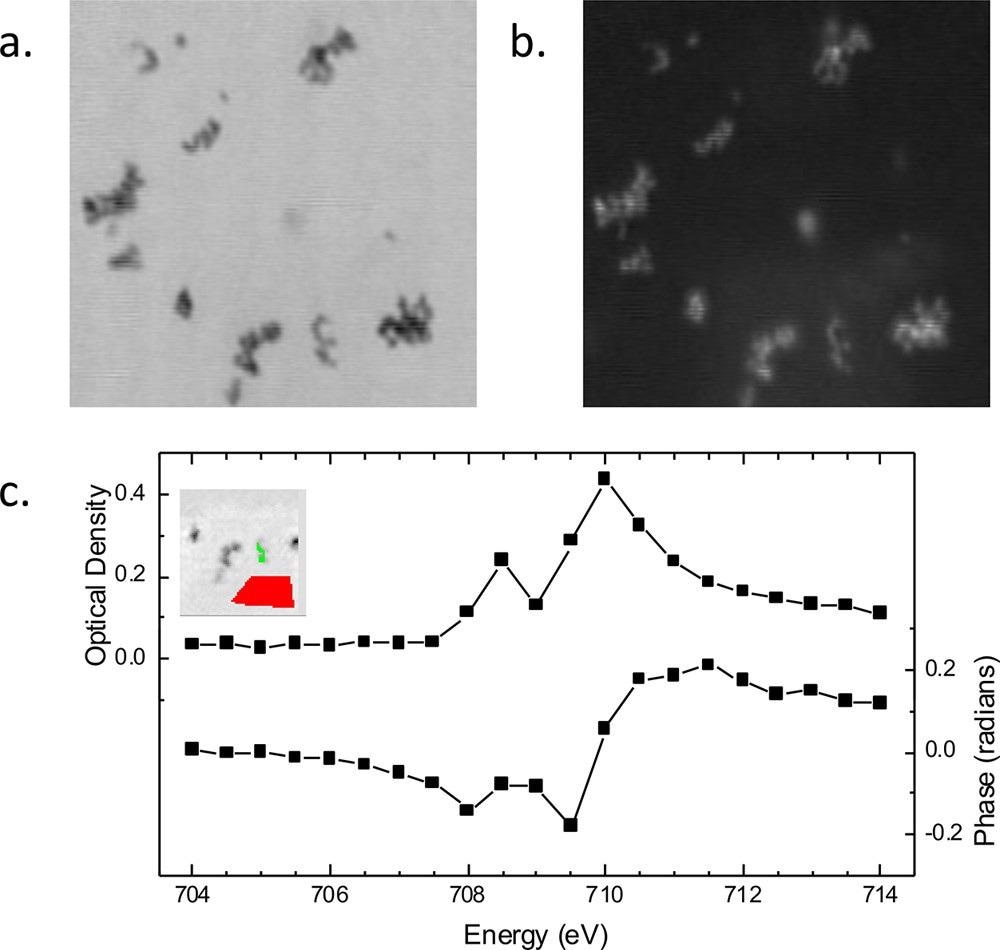
Figure 2. Spectroptychography of 30 nm diameter Fe2O3 nanoparticles. Amplitude (a) and phase (b) ptychography images, recorded at 710.0 eV. Image size is 2.1 × 2.1 μm. (c) Absorption (optical density) and phase Fe L3 spectra obtained from this sample. (Inset) Region from which the sample signal for amplitude and phase (green region) was extracted. Amplitude signal from an open area (red region) was used for the incidence flux in the calculation of the sample optical density using Beer’s law, −ln(I/Io). © Urquhart (2022)
Other Aspects Related to X-ray Spectroptychography
Spectroptychotomography
Three-dimensional (3D) mapping using spectroptychotomography can help in avoiding spurious correlations in two-dimensional (2D) transmission imaging. For instance, a “sparse” spectroptychotomography study based on the simultaneous algebraic reconstruction technique (SART) was used to reduce the number of projections needed to obtain a high-quality reconstruction.
Although multi-energy spectroptychotomography studies can provide chemical mapping in a detailed manner, these studies are often restricted to radiation-resistant materials and are extremely time-consuming.
Extended X-ray Absorption Fine Structure (EXAFS) Spectroptychography
EXAFS spectroptychography requires several photon energies to provide an interferogram, which can be then Fourier transformed to obtain a radial distribution function. However, EXAFS spectroptychography studies require excellent stability and are time-consuming.
In Situ and Operando Spectroptychography
This technique can be potentially used to investigate samples in realistic and varied conditions. However, the dwell times needed for ptychography measurements and the requirement for several energies for spectroscopic sensitivity are the major challenges of in situ studies.
X-ray Linear Dichroism Spectroptychography
This technique can be used in several applications. For instance, the linear dichroism of a vanadium pentoxide crystal was investigated by X-ray linear dichroism spectroptychography at orthogonal polarization states and the V K edge to obtain phase and absorption maps of polycrystalline vanadium pentoxide.
Future of X-ray Spectroptychography
X-ray spectroptychography and ptychography are rapidly becoming the preferred synchrotron techniques for optics and instrumentation. However, the phase spectra and images of materials with complex structures obtained by these techniques cannot be easily rationalized, which is a major drawback. Phase spectra can reveal additional sample-related information, while phase images can be used to a limited extent for chemical imaging of samples with decreased radiation damage.
Additionally, X-ray cameras display reduced sensitivity at lower photon energies, which limits the application of spectroptychography in different materials such as lithium-ion batteries and organic electronic batteries. A more consistent signal-to-noise ratio is required to obtain higher spatial resolution measurements. Recent studies have demonstrated that spectroptychography has significant potential for correlative imaging when it is used with other microscopy techniques.
Complex ptychographic data sets can be analyzed using statistical methods such as machine learning, which can help in the translation of advanced statistical analysis and reconstruction methods to experimentally accessible tools.
To summarize, X-ray spectroptychography is fast becoming a mainstream method for the chemical microanalysis of nanomaterials. However, the time required for data acquisition remains a challenge in this technique.
News
Specially engineered antibody delivers RNA therapy to treatment-resistant tumors
Elias Quijano, PhD; Diana Martinez-Saucedo, PhD; Zaira Ianniello, PhD; and Natasha Pinto-Medici, PhD, there are 25 other contributors, most from Yale's Department of Therapeutic Radiology and from the departments of genetics, molecular biophysics and [...]
Vaccinated women face fewer cervical cancer risks
New data from Denmark shows the HPV vaccine’s powerful long-term impact, while also revealing why cervical cancer screening is still essential. A Danish study published in the journal Eurosurveillance reports that women who received the human [...]
3D-printed implant offers a potential new route to repair spinal cord injuries
A research team at RCSI University of Medicine and Health Sciences has developed a 3-D printed implant to deliver electrical stimulation to injured areas of the spinal cord, offering a potential new route to [...]
Nanocrystals Carrying Radioisotopes Offer New Hope for Cancer Treatment
The Science Scientists have developed tiny nanocrystal particles made up of isotopes of the elements lanthanum, vanadium, and oxygen for use in treating cancer. These crystals are smaller than many microbes and can carry isotopes of [...]
New Once-a-Week Shot Promises Life-Changing Relief for Parkinson’s Patients
A once-a-week shot from Australian scientists could spare people with Parkinson’s the grind of taking pills several times a day. The tiny, biodegradable gel sits under the skin and releases steady doses of two [...]
Weekly injectable drug offers hope for Parkinson’s patients
A new weekly injectable drug could transform the lives of more than eight million people living with Parkinson's disease, potentially replacing the need for multiple daily tablets. Scientists from the University of South Australia [...]
Most Plastic in the Ocean Is Invisible—And Deadly
Nanoplastics—particles smaller than a human hair—can pass through cell walls and enter the food web. New research suggest 27 million metric tons of nanoplastics are spread across just the top layer of the North [...]
Repurposed drugs could calm the immune system’s response to nanomedicine
An international study led by researchers at the University of Colorado Anschutz Medical Campus has identified a promising strategy to enhance the safety of nanomedicines, advanced therapies often used in cancer and vaccine treatments, [...]
Nano-Enhanced Hydrogel Strategies for Cartilage Repair
A recent article in Engineering describes the development of a protein-based nanocomposite hydrogel designed to deliver two therapeutic agents—dexamethasone (Dex) and kartogenin (KGN)—to support cartilage repair. The hydrogel is engineered to modulate immune responses and promote [...]
New Cancer Drug Blocks Tumors Without Debilitating Side Effects
A new drug targets RAS-PI3Kα pathways without harmful side effects. It was developed using high-performance computing and AI. A new cancer drug candidate, developed through a collaboration between Lawrence Livermore National Laboratory (LLNL), BridgeBio Oncology [...]
Scientists Are Pretty Close to Replicating the First Thing That Ever Lived
For 400 million years, a leading hypothesis claims, Earth was an “RNA World,” meaning that life must’ve first replicated from RNA before the arrival of proteins and DNA. Unfortunately, scientists have failed to find [...]
Why ‘Peniaphobia’ Is Exploding Among Young People (And Why We Should Be Concerned)
An insidious illness is taking hold among a growing proportion of young people. Little known to the general public, peniaphobia—the fear of becoming poor—is gaining ground among teens and young adults. Discover the causes [...]
Team finds flawed data in recent study relevant to coronavirus antiviral development
The COVID pandemic illustrated how urgently we need antiviral medications capable of treating coronavirus infections. To aid this effort, researchers quickly homed in on part of SARS-CoV-2's molecular structure known as the NiRAN domain—an [...]
Drug-Coated Neural Implants Reduce Immune Rejection
Summary: A new study shows that coating neural prosthetic implants with the anti-inflammatory drug dexamethasone helps reduce the body’s immune response and scar tissue formation. This strategy enhances the long-term performance and stability of electrodes [...]
Scientists discover cancer-fighting bacteria that ‘soak up’ forever chemicals in the body
A family of healthy bacteria may help 'soak up' toxic forever chemicals in the body, warding off their cancerous effects. Forever chemicals, also known as PFAS (per- and polyfluoroalkyl substances), are toxic chemicals that [...]
Johns Hopkins Researchers Uncover a New Way To Kill Cancer Cells
A new study reveals that blocking ribosomal RNA production rewires cancer cell behavior and could help treat genetically unstable tumors. Researchers at the Johns Hopkins Kimmel Cancer Center and the Department of Radiation Oncology and Molecular [...]

